
In the late winters and springs of 2022 I found I was walking through Soho and its bordering neighborhoods, Chinatown and the Lower East Side. Already, I have assembled pages for Prince Street and Spring Street; today’s subject, Grand Street, and Broome and Delancey may follow. Grand and Broome are the lengthiest and I’ll see as I compose this page if I’ll have to do a Part Two.
Photos in batch: 109
Date: May 15, 2022
Today, usage of the words grand and great to refer to size is deemphasized, but when a number of NYC locations was established, that wasn’t the case, as seen by names such as Great Jones Street (which is wider than nearby streets) and Great Kills. Today, great and grand refer more to value, though we hold onto terms like “great big” and the adverb greatly. Derivations of Manhattan’s Grand Street differ (Sanna Fierstein in Naming New York says it was laid out as a grand boulevard leading to the 19th Century’s planned Delancey Square) but the term likely refers to its width, which was considerable for the 19th Century, especially in its eastern stretch.
All five boroughs have one or more streets named “Grand” and in most cases they are of exceptional length (though not in Staten Island); Grand Street in Brooklyn and Grand Avenue in Queens are a continuous road and, as part of Broadway and 30th Avenue (originally called Grand Avenue) can be said to go all the way to Astoria. The most obvious example is the Grand Concourse in the Bronx, which is overdue for a revisit with the FNY camera.

Though house numbering of a number of cross streets in Soho runs erst to west, Grand Street has (to me) the more natural progression of house numbering of west to east. Fronting on #80 Varick, this Moderne loft building also has a side entrance, #2-6 Grand. It has been converted to residences and interiors are viewable here. Across Grand street, the spot where #1 Grand would be has been an empty lot for several years that has been occupied by flea markets, pop up parks and various installations.

What did new buildings look like in 1990? Your answer is here at #101 6th Avenue on the NW corner of Grand, a mixed-use commercial and residential building. Had it been built after 2000, the exterior would have likely been completely glass.

When 6th Avenue was extended south from Greenwich Village atop the then-new underground IND Subway, it absorbed some small streets and orphaned stretches of others. This unmarked road, now used by kids for hopscotch, is actually the southern end of Sullivan Street, whose original southern end was on Canal.
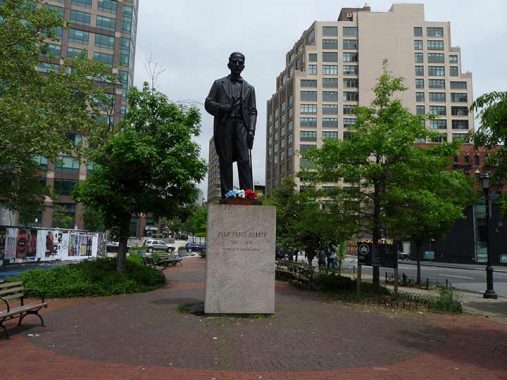
The space between 6th Avenue, Canal Street and Sullivan (now called 6th Avenue) is vast, windswept and red-bricked; at the center stands a statue of Juan Pablo Duarte, considered a founder of the Dominican Republic.
He was born in Santo Domingo in 1813; after studying in Spain from 1828 to 1833, he returned to the island of Hispaniola and conferred with several patriots and organized a secret society, La Trinitaria, to work for independence from Haiti. The Dominican Republic achieved independence from Haiti in 1844. Duarte and his followers did not gain power, however; the Dominican Republic became a military dictatorship. Duarte moved to Venezuela, where he lived most of the rest of his life.
His likeness here was sculpted by Nicola Arrighina and installed in 1978.
Political South American luminaries are recalled in statues all along 6th Avenue up to Central Park. In 1945 Mayor Fiorello LaGuardia renamed 6th Avenue “Avenue of the Americas” and medallions featuring states in North, Central and South America were installed on lampposts around 1960. New Yorkers persisted in calling Sixth Avenue by its easier numbered name, and most of the medallions were removed during a renovation in the early 1990s.

None could say with precision how old the Moondance, on 6th Avenue and Grand Street, was; most accounts had it there as early as 1933, making it the oldest freestanding diner in the city. It was originally known as the Holland Tunnel Diner (the tunnel mouth is a block away on Varick). The railway car-inspired diner retains several original and/or distinctive elements; chrome detailing, a barrel roof ceiling, wrap-around windows, counter & stools, as well as a famed retro revolving moon sign by the late architect/designer Alan Buchsbaum & designer/signmaker Jim Rogers. Actresses Courtney Cox and Kirsten Dunst have played Moondance Diner employees on TV and the movies.
After decades as a somewhat humble greasy spoon, restaurateur Larry Panish upgraded the decor and menu in the 1990s without sacrificing a classic diner feel before selling in 2001. Diner owners, The Extell Group, was set to demolish the diner and construct a high ride condo in its place. However, concerned citizens spoke up: Michael Perlman, Queens preservationist & founder of the Committee To Save The Moondance Diner, and Kyle Supley, Brooklyn preservationist, immediately joined forces & campaigned to save the diner, when its fate was in limbo in 2007.
Extell donated it to the American Diner Museum, which, in turn, sold it to Vince and Cheryl Pierce of LaBarge, Wyoming, where they moved it in 2007′ unfortunately it was closed and put up for sale in 2012, and I have lost track of its fate. The James Hotel replaced the Moondance at 6th and Grand in 2009 (architect: Eran Chen). It is part of a chain of luxury hotels with franchises in Chicago and New York. Of interest is its rooftop pool and bar, “The Jimmy.”
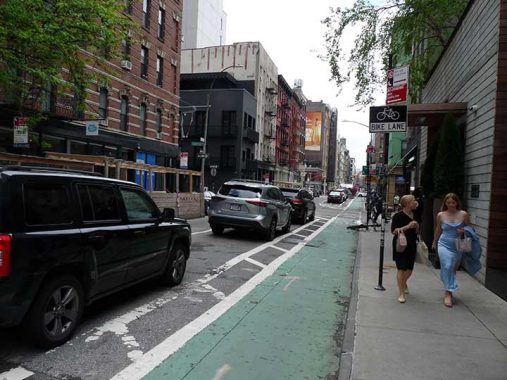
When opened in the very early 1800s Grand street was thought to be “grand” or wider than its fellow streets. That wideness has been blunted by the addition of parking and bicycle lanes, and the city has allowed dangerous conditions to arise by permitting the construction of outdoor restaurant sheds in the parking lanes on occasion, outside the bike lanes. This means that waiters have to wait for speeding bicycles when delivering orders.
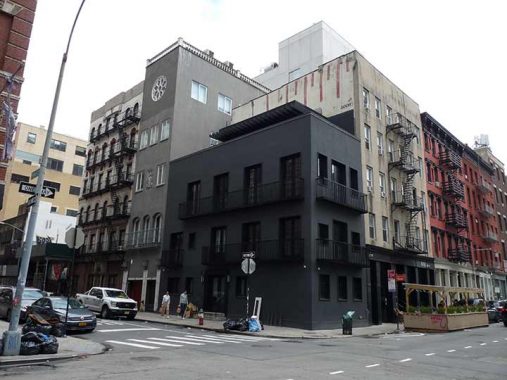
The town house on the NE corner of Grand and Thompson has been renovated over the years to be ever more streamlined and bland, compared to its fellows from the 19th Century.
Though I grant that gutter sheds have allowed restaurants to increase sitting capacity, and some are well-designed and kept, many are eyesores. Restaurant Felix, Grand Street and West Broadway, has its own gutter shed that was empty on this mild 75-80 degree afternoon, with sidewalk and interior seating sufficing. (I have no idea why anyone sits outdoors to eat in the gritty Manhattan streets.)
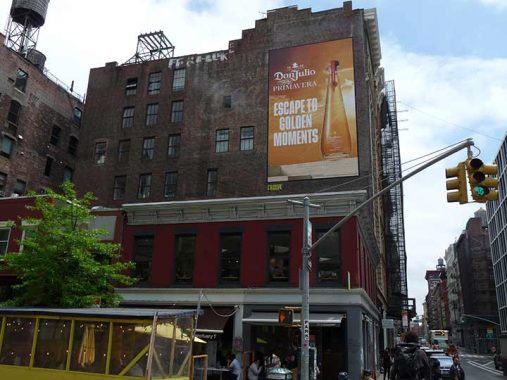
I wish I knew the history of this low-rise, two-story structure on the NE corner of West Broadway and Grand. I have monitored the status of the painted ad for Coca-Cola on the building behind it, which has been partially covered by a series of newer ads the past decade.
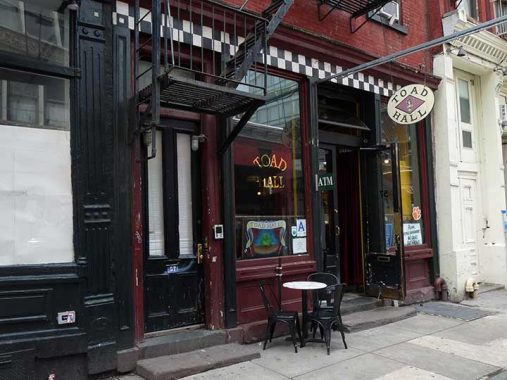
Toad Hall at #57 Grand is named for the home of Mr. Toad in the 1908 children’s novel Wind in the Willows by Kenneth Grahame that wasn’t really written for children.
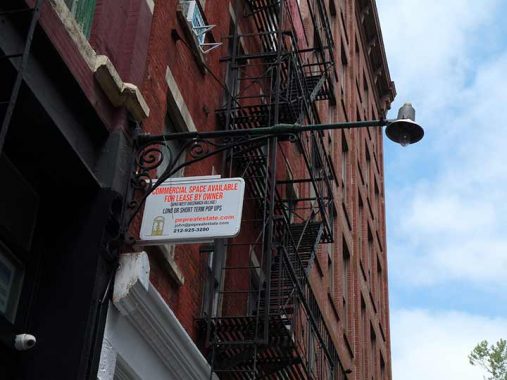
Each time I am in this area of Soho I check on this Type G wall lamp, one of about 20 remaining in NYC, at 41 Wooster Street north of Grand. It’s the only National Electrical Manufacturers Association (NEMA) luminaire in public use in NYC, though I’m not sure if the Department of Transportation services it. Unfortunately its bulb seems burned out and it has lost its reflector bowl. Other NEMA fixtures can be seen here. And, here is what it looks like with its bowl.
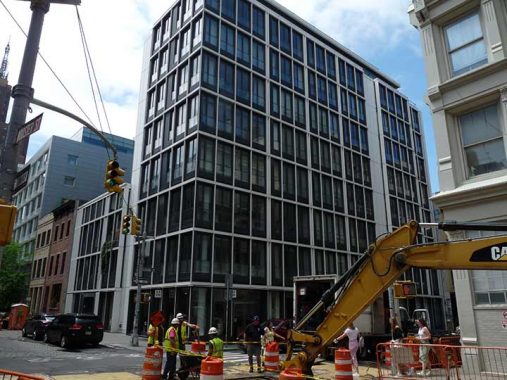
How did modern condominium #27 Wooster, the SW corner of Grand, get built in the landmarked Soho Cast Iron District? Prior to 2012, this was a parking lot and thus no historic structures had to be altered or torn down. To be frank, I like the design, as it’s not a pure glassy front, and has equally sized windows that appeal to my esthetic sense of order. I like its contrast with Belgian-blocked Wooster. As with all modern day residences, just keep the shades shut if your habit is to wear little around the house.
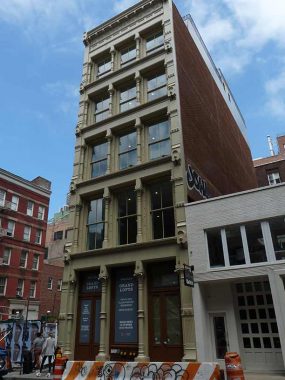
The contrast of modern construction with #74 Grand, built in 1885, is striking. Its original owner was Ambrose Kingsland (1804-1878), sperm whale oil manufacturer and Whig mayor of NYC from 1851 to 1853. He initiated legislation to build Central Park was otherwise an ineffective mayor and returned to his lucrative importing business when he was defeated for reelection. He owned a good deal of land in Greenpoint, Brooklyn, whose Kingsland Avenue was named for him. He is interred in Green-Wood Cemetery.
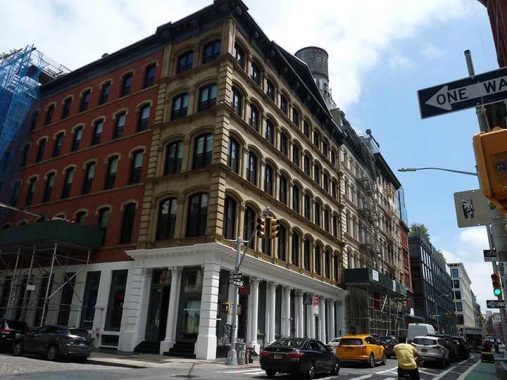
From the Soho Cast Iron District LPC report:
#90-94 {Grand at Greene Street] is a handsome five-story stone structure located on the northeast corner of Grand and ·Greene Street. This 1867 building, which incorporates a castiron storefront supported .by ·Corinthian columns, is an outstanding example of the transitional style from the Italianate to French modes that was typical of the period as a whole and specifically of Griffith Thomas, the architect for this building.
A casual walk through the Castiron District will flatten any architectural aficionado who isn’t familiar with it.
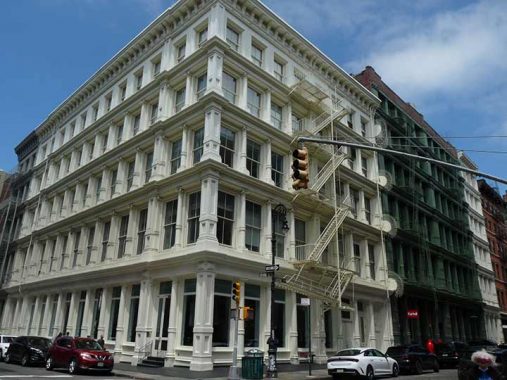
Constructed in stone with a cast iron front in 1873, the massive #80-88 Grand street at Greene was for many years home to importers C.A. Auffmordt & Co, now residences. Importers and merchants of dry goods dominated Soho before it was called Soho and changed character completely; these were built as utilitarian buildings, amazing as that seems today.
If you’re interested in cast iron architecture, your Bible should be “Cast-Iron Architecture in New York: A Photographic Survey” by Margot Gayle and Edmund V. Gillon Jr., Dover 1974, which is chockablock of photos of Soho in the 1970s, when it was that gritty era I have been talking about. It was Margot Gayle who wrangled the department of Transportation into saving many of Manhattan’s original cast iron streetlamps.
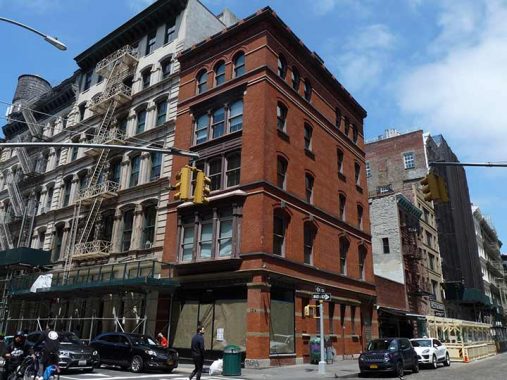
#104 Grand at Mercer was built in 1883, after the first great flush of cast iron front construction in the mid-1800s, but this brick, iron and stone construction could probably survive pretty much anything.

40 Mercer is a 13-story, 40-unit luxury condominium completed in 2007 and one again, it occupied a lot left empty for many years after an 1858 Lord & Taylor store designed by by Griffith Thomas burned down in 1960.
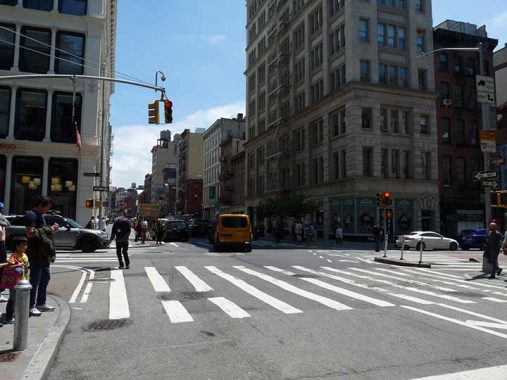
It’s hard to tell from this angle, but Grand Street takes a nearly imperceptible jog at Broadway, a distinction now made on zoomable computer maps but not paper maps. This tells me that Grand Street was likely first developed in the early 1800s in sections and that one of them was divided by Broadway. Other factor could enter into it too, such as the removal of high ground or now-underground streams. What I would give for an H.G .Wells-style time machine — I’d set the controls for 1835 or so just to see how this sort of thing came about.
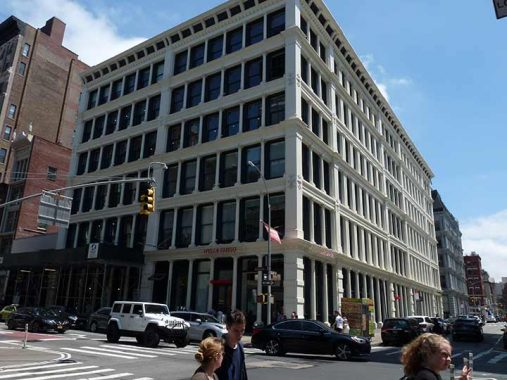
More from the LPC Report:
Nos. 462-464 and 466-468 Broadway (120-132 Grand) form an impressive corner building which runs along Grand Street to Crosby Street. Designed by John Correja for George Bliss and J. Cossitt is 1879-1880, it is a massive example of a cast-iron commercial palace done in a French Renaissance vein. Its six stories are combined into a total of twelve bays on the Broadway side and 24 bays on the Grand Street side.
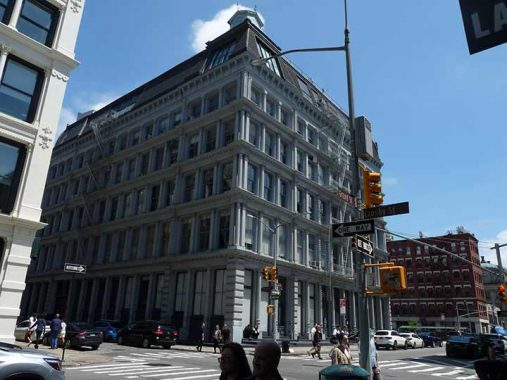
Built in 1896, #134-140 Grand street at Crosby is both a late-period Second Empire design (you can tell by the slanted roofline) and late-period cast-iron front.
#141-145 Grand Street, the south side between Crosby and Lafayette, are among some of the oldest buildings on Grand, constructed in 1822, with their 4th floors added in the 1850s. Adjoining #147-149 went up in the 1820s as well but were considerably altered in the late 1880s. The “E TERMANN” may be all that remains of a building signature installed by 1880s owner W. & G. Deutermann. (He may have shortened his name)
For over a decade, the New York City Department of Environmental Protection (DEP) has conducted drilling beneath Grand and Lafayette Streets toward the decades old Water Tunnel #3 Project. The surface work here is finally done, and when I passed the space in May 2022 it was ready to become an (admittedly low on shade) park, though the gates were still locked. I have been tipped that they are indeed open now, though I don’t know the new park’s official name. If you do, Comments are open.
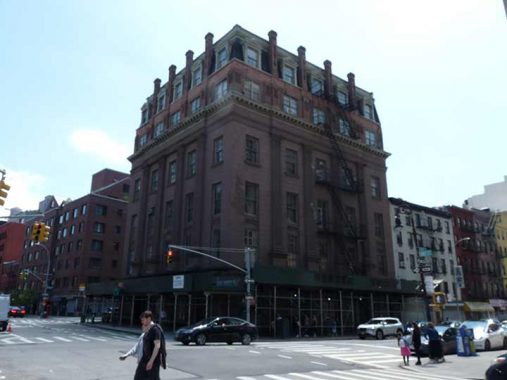
The Italianate Odd Fellows Hall at #165-171 Grand Street, the SE corner of Centre, was constructed from 1847-1848 with a Second Empire-style slanted roof addition in 1882. The Independent Order of Odd Fellows, a secret society, was founded in
Manchester, England, in the early 1800s. The organization described its purpose “To visit the sick, relieve the distressed, to bury the dead, and to educate the orphan,” and in addition to be tile “Guardian of the Widow, and Father of the Fatherless.” The New York branch was founded in 1806. Like the Masons, the IOOF still has a very wide worldwide membership. Such fraternities were unusual in England at the time of the IOOF’s foundation, hence the name.
The domed former NYPD Headquarters, 240 Center Street, located in a wedge between Centre, Grand, Broome, and Centre Market Place. Currently a super-luxury apartment building called Police Building Apartments, it was designed by Hoppin & Krohn and completed in 1909 just as the Beaux Arts movement was beginning to wind down and modernism was around the corner. The lions in front look rather more fierce than the two at the New York Public Library – as befits Police HQ. It was converted to luxury use in 1988, a very early harbinger of the luxe trend that would take hold in Soho in the following decade.
This is an original Type 1A Bishop Crook lamp, recognizable by its thinner, garland-wound shaft and ladder rest, an homage to gaslamps. It was installed during the 1910s. Part of it was given a new paint job to relieve its rust and a new Bell lamp fixture some years ago.
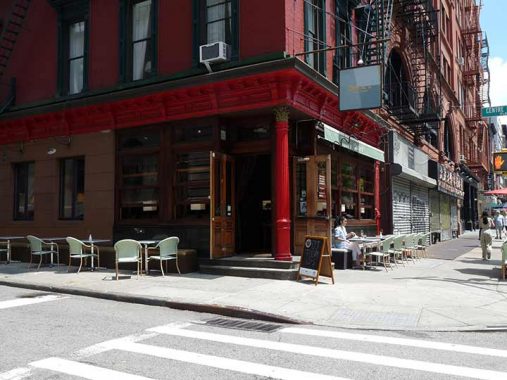
One of the oldest taverns in NYC, on the corner of Grand, ONieals (the official spelling deprives it of two apostrophes), was established as Callahan’s around 1880. After the NYPD HQ went up across the street a tunnel was dug from the HQ to this bar for easy undetected access for cops and NYPD brass; part of it is now ONieals wine cellar. There was an upstairs brothel at one point, and the place continued to run as a speakeasy during prohibition.
The NYPD HQ was retired in 1973, but the bar soldiered on and was purchased by its current management in 1996.
As I suspected I would do, I am going to split Grand Street into a Part 2, which will be my next longform post. After a pair of long walks thanks to non-humid weather this weekend, I’m in the mood to relax this evening before returning to work Monday morning. The remainder of Grand Street takes you through Little Italy, Chinatown and the Lower East Side.
As always, “comment…as you see fit.” I earn a small payment when you click on any ad on the site.
6/19/22


3 comments
The old NYPD Headquarters are often shown in episodes of “Car 54 Where Are You?”. When the boys had to go “Downtown”.
As a child, the first time I heard of the Odd Fellows was in a Three Stooges short, in which they are convicts transported from England to North America in the 1600’s. They are sent to the frontier and put to work hunting game. Moe and Larry boast, “I shall bag a moose!” “I shall bag an elk!” and Curly says, “Perhaps even an Odd Fellow!” (the reference being of course to the Moose and Elks Lodges). I believe Moe then slaps Curly and tells him, “Thou ART an odd fellow!”
Was the Moondance Diner named after the Van Morrison song ?